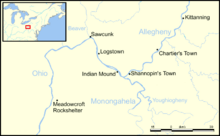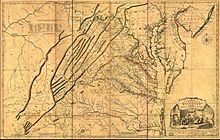Logstown facts for kids
Quick facts for kids
Logstown
Maughwawame
|
|
|---|---|
|
Historic Native American village
|
|

The stone marker at or near the former site of Logstown (1725-1758)
|
|
| Etymology: Unami: maughwawame "extensive flats" | |

Location in Beaver County and state of Pennsylvania
|
|
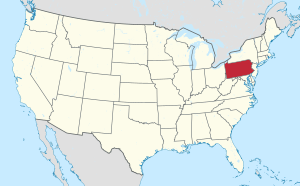
Location of Pennsylvania in the United States
|
|
| State | Pennsylvania |
| Present-day Community | Harmony Township, Beaver County, Pennsylvania |
| Founded | 1725-1727 |
| Demolished | June, 1754 |
| Rebuilt | 1755-58 |
| Abandoned | November 1758 |
| Population | |
| • Estimate
(1754)
|
200-500 |
Logstown was an important Native American village in what is now Western Pennsylvania. It existed from around 1726 to 1758. The French called it Chiningue. It was located near modern-day Baden, Pennsylvania.
Logstown was a very large settlement for its time. Its location on the Ohio River made it a key spot for trade and meetings. Both the British and French, who were fighting for control of the Ohio Country, saw Logstown as important. They both tried to build forts near the village. In 1752, the Treaty of Logstown was signed here. This agreement involved the Ohio Company, the Colony of Virginia, and the Six Nations. Logstown was burned down in 1754. Even though it was rebuilt, it was eventually abandoned after the French and Indian War.
Contents
Where Was Logstown Located?
Logstown was in Harmony Township, Beaver County, Pennsylvania. This is about 14 miles northwest of where Pittsburgh is today. It was on the east bank of the Ohio River, across from Aliquippa.
Today, a stone marker with a brass plaque shows where the village once stood. The Daughters of the American Revolution placed it there in 1932. It remembers George Washington's visit in November 1753.
What Does "Logstown" Mean?
Some people believe Logstown got its name because the French built about 30 log cabins there in 1747. These cabins were on a flat area above the village.
However, historian George P. Donehoo said the name probably came from the many logs left on the flat land after floods in the Ohio River.
The original Lenape name for the village was Maughwawame. This means "extensive flats," describing the wide, flat land where the village was built.
The French called the town "Chiningue." Father Joseph Pierre de Bonnecamps, who traveled with the French, said they named it after a nearby river. Some think chiningue is a French word for beaver. Others believe it comes from ochenango, a Seneca word for "large bull thistles."
Early Days of Logstown
The first people to settle Logstown were the Shawnees. They may have arrived as early as 1725 or 1730. The village was built on low land near present-day Ambridge.
The village grew as groups of Lenape, Cayugas, Senecas, and Shawnees moved west. They were trying to escape diseases and droughts. This made Logstown a community with many different Native American groups. In 1744, Kakowatcheky and his Shawnee warriors arrived, making the town much larger. Kakowatcheky is sometimes seen as a founder of Logstown. The village's population ranged from about 200 to 500 people.
In 1745, the Shawnee leader Peter Chartier visited Logstown. He wanted Kakowatcheky to join him in seeking French protection. Chartier was unhappy with the Pennsylvania government. Kakowatcheky refused to join, and Chartier left after a short stay.
Most of Logstown was on the flat land along the Ohio River. Some buildings were on the west bank too. The villagers grew maize (corn), beans, squash, and other crops on the fertile land on both sides of the river. A few homes were also built on a higher grassy area, called the "upper town."
In 1747, the Six Nations Confederacy sent two important leaders, Tanacharison (a Seneca) and Scarouady (an Oneida), to live in Logstown. They were there to oversee the Iroquois allies, like the Delawares and Shawnees.
British Visits and Treaties
George Croghan's Visit in 1748
The Pennsylvania government wanted to keep Native Americans in the Ohio Valley allied with the British. French agents were visiting tribes and trying to make alliances. In 1747, George Croghan, a British trader, warned that the Native Americans might side with the French if they didn't receive supplies.
In November 1747, Scarouady and other Iroquois leaders signed a treaty in Philadelphia. It promised a military alliance against the French in exchange for supplies. Croghan went to Logstown in April 1748 to confirm this treaty. He met with 1500 men and gave them extra gifts from his own supplies. This helped keep the alliance strong.
Later that year, fifty-five Native American representatives signed a peace treaty in Lancaster, Pennsylvania. This treaty allowed the British to trade with tribes across a wide area, which was a big success for the British.
Conrad Weiser's Visit in 1748
In August 1748, Conrad Weiser, Pennsylvania's ambassador to the Six Nations, arrived in Logstown. Many Native Americans gathered, including leaders from the Wyandot, Delaware, Shawnee, and Iroquois tribes.
Weiser announced that King George's War had ended. He distributed gifts since there were no more war supplies. He also asked for a count of warriors in the Ohio Valley. The total was 789 warriors from various tribes.
More than twenty English traders came with Weiser to set up trade with the tribes. This was meant to strengthen ties and keep the French out.
After the gifts were given, the chiefs thanked Weiser and Croghan. They said, "Our brethren the White Men have indeed tied our hearts to theirs."
Benjamin Franklin's son, William Franklin, also came on this trip. He was only nineteen. His journey later made his father very interested in the frontier.
Treaty of Logstown in 1752
In 1749, the British King gave the Ohio Company a large piece of land (500,000 acres) in the Ohio Country. The company had to settle 100 families and build a fort within seven years. The Treaty of Logstown was meant to help the Ohio Company meet these goals. It also aimed to get clear permission to build a fort.
From June 1 to 13, 1752, British officials met with representatives of the Six Nations, Lenape, and Shawnee tribes in Logstown. The British wanted to confirm an earlier treaty from 1744. They also wanted permission to build a fort where the Monongahela and Allegheny rivers meet (modern-day Pittsburgh). They hoped to open up new land for British settlements.
The Iroquois leader, Tanacharison, at first said the land sold in 1744 did not go past the Allegheny Mountains. But he was eventually pressured to give up more land. The British tried to assure the Native Americans that they would still have access to these lands.
After much discussion, Tanacharison agreed to let the British build a fort at the mouth of the Monongahela River. This is where Fort Duquesne (later Fort Pitt) was built. However, other Native American leaders, like Scarouady, warned that they intended to keep their country free of settlements. Tanacharison himself later said that the land belonged to neither the French nor the English.
Shingas Becomes Lenape Chief
During the Logstown treaty, Tanacharison chose Shingas to be the new chief of the Lenape people. The Lenape had not had a strong leader since 1747. Tanacharison announced to the Virginia officials, "we have given our Cousins, the Delawars, a King." Shingas was not there, so his brother Tamaqua stood in for him.
French Visits and Attempts to Build a Fort
Céloron de Blainville's Visit in 1749
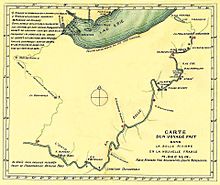
In 1749, the French wanted to show their power over the Ohio Country. The Governor of New France sent Pierre Joseph Céloron de Blainville down the Ohio River. He led a large group of soldiers and Native American allies. Céloron buried lead plates and nailed copper plates to trees to claim the land for France.
Céloron arrived at Logstown on August 8, 1749. The Shawnee chief Kakowatcheky prepared for a fight. He stood by the English flag and told his young men to be ready.
A French priest with Céloron described Logstown as a new village, only five or six years old. He said most of the people were Iroquois warriors.
Céloron found British traders living in Logstown. He was angry and told them to leave French territory. The Native American chiefs apologized for the English flag. They said it was just for show.
However, a British trader named William Trent said the Native Americans fired their guns into the ground near the Frenchmen's feet. They asked the English traders if they should kill the French. The English traders felt sorry for the French and told them not to.
Céloron warned the chiefs that he knew how to fight. He then delivered a message from the Governor of New France. It said the English were deceiving the Ohio tribes and planning their "total ruin." The old chief Kakowatcheky was reportedly very angry.
Céloron then told the British traders to leave. They said they would, admitting they had no right to trade there. Céloron gave gifts and left Logstown on August 12.
After Céloron left, George Croghan visited Logstown. The Native Americans told him they had told Céloron that the land was theirs. They said they would continue to trade with the English. They added that separating them from the English would be like "cutting a man in two halves."
Chabert de Joncaire's Visit in 1750-51
After Céloron's trip, the new Governor-General of New France decided to send Philippe-Thomas Chabert de Joncaire back to Logstown. He was to set up a permanent French base. In July 1750, Joncaire left Montreal with supplies and gifts. He was ordered to build a two-story trading house with loopholes for defense. He was also to explore the region and build relationships with other chiefs.
Throughout the fall of 1750, Pennsylvania received reports that Joncaire was giving gifts and gaining influence with the Native Americans.
Croghan returned to Logstown in November 1750. He found Joncaire there, who planned to build a fort if the Ohio Native Americans allowed it.
The Pennsylvania government sent Croghan and Andrew Montour back to Logstown with more gifts. They arrived in May 1751 and were welcomed. Joncaire arrived two days later. He held a council and challenged the Logstown leaders to stop trading with the English. He gave them a large wampum belt to show the importance of his message.
The Native American leaders rejected Joncaire's challenge. They returned the wampum belt, showing they would not end trade with the English.
Joncaire later told Croghan that he was just following orders. He believed the French would not succeed in controlling the Six Nations without force.
At another meeting, a Six Nations speaker told Joncaire directly, "Is it not our land?" He told Joncaire to leave and ask the Governor of New France why he was acting this way. Joncaire seemed to give up on building a fort. Instead, the French began building a series of forts further north, like Fort Presque Isle and Fort Le Boeuf.
French Fort Plans in 1754
The Ohio Iroquois had not wanted the English to build forts in their region. But by 1750, some Native Americans in Logstown thought an English fort might be good to protect trade. Governor Hamilton of Pennsylvania wanted to build a fort. However, Andrew Montour said the Native Americans had only agreed to think about it, not actually asked for one. So, Pennsylvania did not fund a fort.
At the Treaty of Logstown in 1752, Tanacharison agreed to a fort being built upriver. But his authority as a "half-king" was limited. In 1754, the Ohio Company began building Fort Prince George. However, the French seized it in April 1754 and built Fort Duquesne there instead. The French then decided a fort at Logstown was not needed.
George Washington's Visit in 1753
In late 1753, Virginia Governor Dinwiddie sent young Major George Washington to tell the French to leave the Ohio Valley. Washington also had to make peace with the Iroquois Confederacy and gather information about French forces.
Washington left Virginia on October 30 with eight men. He stopped at Christopher Gist's home, and Gist joined him.
They arrived in Logstown on November 23. Washington met with Shingas, Scarouady, and Tanacharison. The chiefs gave Washington information about the best route to Fort Le Boeuf. Washington explained his mission, and the Native Americans promised their friendship.
Tanacharison insisted on going with Washington for protection. He, along with other chiefs, volunteered to return three wampum belts that the French had sent. Returning the wampum showed that the Logstown chiefs were allied with the English. Washington wrote that returning wampum meant "abolishing of Agreements."
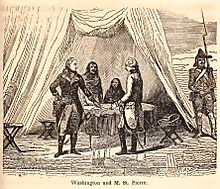
While in Logstown, Washington met four French soldiers who had left their army. They had heard that the French commander, Marin, had died.
Washington and his group left Logstown on November 30. They reached Venango on December 4. There, they met Philippe-Thomas Chabert de Joncaire. It took Washington three days to convince them to go to Fort Le Boeuf. There, they met the French commander Jacques Legardeur de Saint-Pierre. Tanacharison tried to return the wampum, but Saint-Pierre refused it. He promised peace and trade. The French refused to leave the area. They gave Washington a reply to take back to Virginia.
Logstown is Destroyed
A few days before Washington surrendered at Fort Necessity in July 1754, Scarouady burned down Logstown. Washington's journal says Scarouady burned his village and moved his people away. Some historians believe the villagers destroyed it because they feared punishment for their alliance with the French. About 200 residents moved to Fort Cumberland and later to the Aughwick Valley.
Later Years of Logstown
Rebuilding in 1755
In March 1755, French forces began rebuilding the village. A French officer passed the site in April 1755 and called it the "Little Shawnee Village."
In December 1755, a captive named Charles Stuart was brought to Logstown. He reported that only three cabins were left. George Croghan sent a Native American named Jo Hickman to Logstown to gather information. Hickman saw "about 100 Indians and 30 English prisoners" there.
Christian Frederick Post visited in December 1758. He wrote that the "New Log's Town" was on a hill. The French had built about thirty houses for the Native Americans.
John McCullough, who was captured in 1756, lived in Logstown for two and a half years. He said Logstown was shaped like a half-circle around a creek. He mentioned an upper and lower town.
Abandonment in 1758
In late 1758, Logstown's residents were invited to move to a new town on the Upper Scioto. This invitation came from the former residents of Lower Shawneetown.
George Washington returned to the area in 1770. He noted in his journal that he "breakfasted at Logstown" with George Croghan and Alexander McKee. But he did not mention any community or people living there. In 1772, Reverend David McClure visited John Gibson at "his house in Logs Town, which was the only house there."
In 1784, Arthur Lee, an Indian Commissioner, visited Fort McIntosh. He wrote that Logstown was "formerly a settlement on both sides of the Ohio."
Legionville in 1792
In 1792, General Anthony Wayne set up a military training base called Legionville where Logstown's "upper town" had been. This was the first basic training camp for the regular U.S. Army. In 1793, the Seneca leader Guyasuta, who had lived in Logstown, met with General Wayne there for peace talks. The site was left empty in 1793 after the troops moved on.
Archaeological Studies
The only known archaeological studies of the Logstown site happened in 1940 and 1942. One attempt in 1942 to find the village was not successful.
In 2019, the National Park Service looked at the route George Washington traveled in 1753. Their report noted that the site of Logstown "has...potential for an archeological survey."
Images for kids
-
Historical marker at the former site of Logstown, near present-day Ambridge in Beaver County, Pennsylvania.


